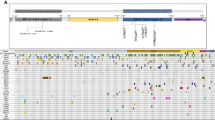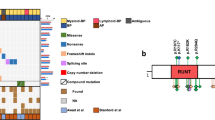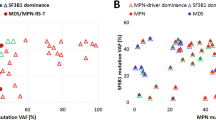Abstract
Primary myelofibrosis (PMF) patients frequently have JAK2 (V617F), CALR (exon 9), or MPL (W515 or exon 10) strong driver gene mutation, which triggers abnormal activation of the JAK2-STATs signaling pathway that plays a complex role in the occurrence of PMF. However, about 10–15% of PMF patients have no above typical mutations in these strong driver genes, known as being “triple-negative”, which are associated with poor prognosis. In this paper, we reported a unique secondary acute myeloid leukemia (sAML) case transformed from triple-negative PMF combined with lung cancer and erythroderma occurrence at the same time, which has not been reported so far. Through whole blood exome sequencing, four novel noncanonical mutations were detected in key regulatory genes SH2B3 (Q748 and S710) and STAT5a (C350 and K354). Meanwhile, STAT5a-S710 and SH2B3-K354 noncanonical mutations gained strong malignant biofunction on promoting cell growth and tumorigenesis by accelerating the G1/S transition. In the mechanistic study, these pernicious phenotypes driven by noncanonical mutations might be initial PMF by activating p-STAT5a/c-Myc/CyclinD1 and p-STAT3/p-AKT/p-ERK1/2 signaling axes. Therefore, our study explored the deleterious roles of novel noncanonical mutations in STAT5a and SH2B3, which may serve as susceptibility genes and display the oncogenic biofunction in the progression of PMF to acute myeloid leukemia-M2a (AML-M2a).
This is a preview of subscription content, access via your institution
Access options
Subscribe to this journal
Receive 12 print issues and online access
$259.00 per year
only $21.58 per issue
Buy this article
- Purchase on Springer Link
- Instant access to full article PDF
Prices may be subject to local taxes which are calculated during checkout








Similar content being viewed by others
Data availability
Correspondence and requests for materials should be addressed to Hao Jiang (jianghao1209@csu.edu.cn).
References
Tefferi A, Mudireddy M, Mannelli F, Begna KH, Patnaik MM, Hanson CA, et al. Blast phase myeloproliferative neoplasm: Mayo-AGIMM study of 410 patients from two separate cohorts. Leukemia. 2018;32:1200–10.
Yogarajah M, Tefferi A. Leukemic transformation in myeloproliferative neoplasms: a literature review on risk, characteristics, and outcome. Mayo Clin Proc. 2017;92:1118–28.
Luque PD, Kralovics R, Skoda RC. Genetic basis and molecular profiling in myeloproliferative neoplasms. Blood. 2023;141:1909–21.
Gangat N, Tefferi A. Myelofibrosis biology and contemporary management. Br J Haematol. 2020;191:152–70.
Morsia E, Gangat N. Myeloproliferative neoplasms with monocytosis. Curr Hematol Malig Rep. 2022;17:46–51.
Tefferi A. Primary myelofibrosis: 2021 update on diagnosis, risk-stratification and management. Am J Hematol. 2021;96:145–62.
Thiele J, Kvasnicka HM, Orazi A, Gianelli U, Gangat N, Vannucchi AM, et al. The international consensus classification of myeloid neoplasms and acute Leukemias: myeloproliferative neoplasms. Am J Hematol. 2023;98:166–79.
Tefferi A. Novel mutations and their functional and clinical relevance in myeloproliferative neoplasms: JAK2, MPL, TET2, ASXL1, CBL, IDH and IKZF1. Leukemia. 2010;24:1128–38.
Klampfl T, Harutyunyan A, Berg T, Gisslinger B, Schalling M, Bagienski K, et al. Genome integrity of myeloproliferative neoplasms in chronic phase and during disease progression. Blood. 2011;118:167–76.
Tefferi A, Lasho TL, Finke CM, Knudson RA, Ketterling R, Hanson CH, et al. CALR vs JAK2 vs MPL-mutated or triple-negative myelofibrosis: clinical, cytogenetic and molecular comparisons. Leukemia. 2014;28:1472–7.
Tefferi A, Vannucchi AM. Genetic Risk assessment in myeloproliferative neoplasms. Mayo Clin Proc. 2017;92:1283–90.
Tefferi A, Nicolosi M, Mudireddy M, Szuber N, Finke CM, Lasho TL, et al. Driver mutations and prognosis in primary myelofibrosis: Mayo-Careggi MPN alliance study of 1,095 patients. Am J Hematol. 2018;93:348–55.
Mascarenhas J, Gleitz H, Chifotides HT, Harrison CN, Verstovsek S, Vannucchi AM, et al. Biological drivers of clinical phenotype in myelofibrosis. Leukemia. 2023;37:255–64.
Tefferi A. Primary myelofibrosis: 2023 update on diagnosis, risk-stratification, and management. Am J Hematol. 2023;98:801–21.
Loscocco GG, Vannucchi AM. Role of JAK inhibitors in myeloproliferative neoplasms: current point of view and perspectives. Int J Hematol. 2022;115:626–44.
Mascarenhas J, Marcellino BK, Lu M, Kremyanskaya M, Fabris F, Sandy L, et al. A phase I study of panobinostat and ruxolitinib in patients with primary myelofibrosis (PMF) and post-polycythemia vera/essential thrombocythemia myelofibrosis (post-PV/ET MF). Leuk Res. 2020;88:106272.
Coltro G, Loscocco GG, Vannucchi AM. Classical Philadelphia-negative myeloproliferative neoplasms (MPNs): a continuum of different disease entities. Int Rev Cell Mol Biol. 2021;365:1–69.
Talpaz M, Kiladjian JJ. Fedratinib, a newly approved treatment for patients with myeloproliferative neoplasm-associated myelofibrosis. Leukemia. 2021;35:1–17.
Zingariello M, Martelli F, Verachi P, Bardelli C, Gobbo F, Mazzarini M, et al. Novel targets to cure primary myelofibrosis from studies on Gata1(low) mice. IUBMB Life. 2020;72:131–41.
Lv K, Jiang J, Donaghy R, Riling CR, Cheng Y, Chandra V, et al. CBL family E3 ubiquitin ligases control JAK2 ubiquitination and stability in hematopoietic stem cells and myeloid malignancies. Genes Dev. 2017;31:1007–23.
Wang LN, Zhang ZT, Wang L, Wei HX, Zhang T, Zhang LM, et al. TGF-beta1/SH2B3 axis regulates anoikis resistance and EMT of lung cancer cells by modulating JAK2/STAT3 and SHP2/Grb2 signaling pathways. Cell Death Dis. 2022;13:472.
Ding LW, Sun QY, Lin DC, Chien W, Hattori N, Dong XM, et al. LNK (SH2B3): paradoxical effects in ovarian cancer. Oncogene. 2015;34:1463–74.
Fasouli ES, Katsantoni E. JAK-STAT in early hematopoiesis and leukemia. Front Cell Dev Biol. 2021;9:669363.
Putri A, Rinaldi I, Louisa M, Koesnoe S. The role of STAT5 in tyrosine kinase inhibitor (IMATINIB) resistance in CML patients. Acta Med Indones. 2019;51:348–52.
Maurer B, Kollmann S, Pickem J, Hoelbl-Kovacic A, Sexl V. STAT5A and STAT5B-twins with different personalities in hematopoiesis and leukemia. Cancers (Basel). 2019;11:1726.
Wu CJ, Sundararajan V, Sheu BC, Huang RY, Wei LH. Activation of STAT3 and STAT5 signaling in epithelial ovarian cancer progression: mechanism and therapeutic opportunity. Cancers (Basel). 2019;12:24.
Holdreith N, Lee G, Chandra V, Salinas CS, Nicholas P, Olson TS, et al. LNK (SH2B3) inhibition expands healthy and Fanconi anemia human hematopoietic stem and progenitor cells. Blood Adv. 2022;6:731–45.
Chen Y, Fang F, Hu Y, Liu Q, Bu D, Tan M, et al. The polymorphisms in LNK gene correlated to the clinical type of myeloproliferative neoplasms. PLoS ONE. 2016;11:e154183.
Pardanani A, Lasho T, Finke C, Oh ST, Gotlib J, Tefferi A. LNK mutation studies in blast-phase myeloproliferative neoplasms, and in chronic-phase disease with TET2, IDH, JAK2 or MPL mutations. Leukemia. 2010;24:1713–8.
Gery S, Gueller S, Chumakova K, Kawamata N, Liu L, Koeffler HP. Adaptor protein Lnk negatively regulates the mutant MPL, MPLW515L associated with myeloproliferative disorders. Blood. 2007;110:3360–4.
Takizawa H, Nishimura S, Takayama N, Oda A, Nishikii H, Morita Y, et al. Lnk regulates integrin alphaIIbbeta3 outside-in signaling in mouse platelets, leading to stabilization of thrombus development in vivo. J Clin Investig. 2010;120:179–90.
Tefferi A, Lasho TL, Guglielmelli P, Finke CM, Rotunno G, Elala Y, et al. Targeted deep sequencing in polycythemia vera and essential thrombocythemia. Blood Adv. 2016;1:21–30.
Grinfeld J, Nangalia J, Baxter EJ, Wedge DC, Angelopoulos N, Cantrill R, et al. Classification and personalized prognosis in myeloproliferative neoplasms. N Engl J Med. 2018;379:1416–30.
Rontauroli S, Carretta C, Parenti S, Bertesi M, Manfredini R. Novel molecular insights into leukemic evolution of myeloproliferative neoplasms: a single cell perspective. Int J Mol Sci. 2022;23:15256.
Pileri A, Pellegrini C, Agostinelli C, Grandi V, Patrizi A, Zinzani PL, et al. Erythroderma and non-Hodgkin T-cell lymphoma: what else, apart from Mycosis Fungoides and Sezary syndrome?. Eur J Dermatol. 2017;27:49–53.
Miyashiro D, Souza B, Torrealba MP, Manfrere KCG, Sato MN, Sanches JA. The role of tumor microenvironment in the pathogenesis of sezary syndrome. Int J Mol Sci 2022;23: 936.
Cui W, Liu Y, Weinstein JS, Craft J, Kaech SM. An interleukin-21-interleukin-10-STAT3 pathway is critical for functional maturation of memory CD8+ T cells. Immunity. 2011;35:792–805.
Luwor RB, Baradaran B, Taylor LE, Iaria J, Nheu TV, Amiry N, et al. Targeting Stat3 and Smad7 to restore TGF-beta cytostatic regulation of tumor cells in vitro and in vivo. Oncogene. 2013;32:2433–41.
Xu Q, Chen S, Hu Y, Huang W. Landscape of immune microenvironment under immune cell infiltration pattern in breast cancer. Front Immunol. 2021;12:711433.
Zeng R, Wu H, Qiu X, Zhuo Z, Sha W, Chen H. Predicting survival and immune microenvironment in colorectal cancer: a STAT signaling-related signature. QJM. 2022;115:596–604.
Zhu M, Li S, Cao X, Rashid K, Liu T. The STAT family: key transcription factors mediating crosstalk between cancer stem cells and tumor immune microenvironment. Semin Cancer Biol. 2023;88:18–31.
Savani M, Dulery R, Bazarbachi AH, Mohty R, Brissot E, Malard F, et al. Allogeneic haematopoietic cell transplantation for myelofibrosis: a real-life perspective[J]. Br J Haematol. 2021;195:495–506.
McLornan DP, Hernandez-Boluda JC, Czerw T, Cross N, Joachim Deeg H, Ditschkowski M, et al. Allogeneic haematopoietic cell transplantation for myelofibrosis: proposed definitions and management strategies for graft failure, poor graft function and relapse: best practice recommendations of the EBMT Chronic Malignancies Working Party. Leukemia. 2021;35:2445–59.
Hernandez-Boluda JC, Pereira A, Kroger N, Beelen D, Robin M, Bornhäuser M, et al. Determinants of survival in myelofibrosis patients undergoing allogeneic hematopoietic cell transplantation. Leukemia. 2021;35:215–24.
Bryan JC, Verstovsek S. Overcoming treatment challenges in myelofibrosis and polycythemia vera: the role of ruxolitinib. Cancer Chemother Pharm. 2016;77:1125–42.
Greenfield G, McPherson S, Mills K, McMullin MF. The ruxolitinib effect: understanding how molecular pathogenesis and epigenetic dysregulation impact therapeutic efficacy in myeloproliferative neoplasms. J Transl Med. 2018;16:360.
Tan J, Chow YP, Zainul AN, Chang KM, Selvaratnam V, Tumian NR, et al. Analysis of genetic variants in myeloproliferative neoplasms using a 22-gene next-generation sequencing panel. BMC Med Genom. 2022;15:10.
Nielsen FC, van Overeem HT, Sorensen CS. Hereditary breast and ovarian cancer: new genes in confined pathways. Nat Rev Cancer. 2016;16:599–612.
Funding
This study was supported by the National Natural Science Foundation of China (Grant Nos. 32000622, 82103184, 81672632, and 81972312), the Science and Technology Innovation Program of Hunan Province of China (Grant No. 2022RC1165), the Natural Science Foundation of Hunan Province of China (Grant Nos. 2021JJ40720, 2021JJ30912, 2021JJ40052,2022JJ40579, and 2023JJ30895), the Research Project of Health Commission of Hunan Province of China (Grant No. 202202085572), Key Research and Development Plan Projects in Hunan Province of China (Grant No. 2022SK2005), and the College Students’ Innovative Entrepreneurial Training Plan Program of Hunan Province of China (Grant No. S2022105330463), The graduate student independent exploration and innovation project of Central South University (2021zzts0081). This work was supported in part by the High Performance Computing Center of Central South University.
Author information
Authors and Affiliations
Contributions
SZ was responsible for conceptualization, investigation, formal analysis, writing the original draft, review and editing the manuscript. JY was responsible for investigation, creation of the figures, writing the original draft, review and editing the manuscript. LH performed the experiments. ZJ was responsible for conceptualization and reviewed and edited the manuscript. HJ was responsible for conceptualization, formal analysis, creation of the figures, review and editing of the manuscript, and funding acquisition.
Corresponding authors
Ethics declarations
Competing interests
The authors declare no competing interests.
Additional information
Publisher’s note Springer Nature remains neutral with regard to jurisdictional claims in published maps and institutional affiliations.
Rights and permissions
Springer Nature or its licensor (e.g. a society or other partner) holds exclusive rights to this article under a publishing agreement with the author(s) or other rightsholder(s); author self-archiving of the accepted manuscript version of this article is solely governed by the terms of such publishing agreement and applicable law.
About this article
Cite this article
Zhang, S., Yan, J., He, L. et al. STAT5a and SH2B3 novel mutations display malignancy roles in a triple-negative primary myelofibrosis patient. Cancer Gene Ther 31, 484–494 (2024). https://doi.org/10.1038/s41417-023-00719-7
Received:
Revised:
Accepted:
Published:
Issue Date:
DOI: https://doi.org/10.1038/s41417-023-00719-7



